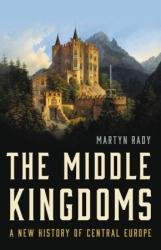 Название: The Middle Kingdoms: A New History of Central Europe
Название: The Middle Kingdoms: A New History of Central EuropeАвтор: Martyn Rady
Издательство: Basic Books
Год: 2023
Страниц: 640
Язык: английский
Формат: epub (true)
Размер: 10.1 MB
An essential new history of Central Europe, the contested lands so often at the heart of world history.
Central Europe has long been infamous as a region beset by war, a place where empires clashed and world wars began. In The Middle Kingdoms, Martyn Rady offers the definitive history of the region, demonstrating that Central Europe has always been more than merely the fault line between West and East. Even as Central European powers warred with their neighbors, the region developed its own cohesive identity and produced tremendous accomplishments in politics, society, and culture. Central Europeans launched the Reformation and Romanticism, developed the philosophy of the Renaissance and the Enlightenment, and advanced some of the twentieth century’s most important artistic movements.
Central Europe rests on its western edge against the River Rhine, which joins the North Sea to the Alps, but its eastern boundary has no obvious physical marker. The Carpathian Mountains, which start northeast of Vienna, in modern-day Slovakia, curl around Hungary and Transylvania, forming a border in the southeast. But further north there is just open country. Northern Europe is flat, lying on the Great European Plain which reaches more than three thousand kilometres from the Low Countries to the Ural Mountains in Russia. On its southern flank, the Great European Plain blends into the steppe land or, as it was once known, the ‘Wild Plain’ that runs through modern-day Ukraine and Central Asia.
It was over the Wild Plain that the dogmen came, bursting out of Central Asia in 1241 and wasting Poland and Hungary. They called themselves Mongols and Tatars, and the second name betrayed (so it was thought) their origin in Tartarus, the classical name for the abyss of hell. Their leader, too, was self-evidently a dog, for he was known as a khan, a name that harked to the Latin word for dog (canis). The behaviour of the Mongols confirmed the connection since, as one French witness related, ‘they ate the bodies of their victims, like so much bread.’ Believing all this, contemporary writers confidently reported that the Mongols were the dog-headed men of antiquity, belonging to the people of Gog and Magog whom Alexander the Great had once walled up in the Caucasus along with sundry giants, corrupt nations, and the unclean people who ate mice and flies. Evidently, something or someone had let them out.
The Mongols were the dogmen of Tartarus or, in another description, the hounds of hell. Although the Mongol Empire rapidly fell apart, one of its successor states preserved the link. From the fifteenth century onwards, the Tatar khans of the Crimea launched successive raids on the Christian kingdoms to the west. They were looking for loot, in the form of slaves, and young ones in particular, whom they would sell in the Crimean port of Kaffa (now Feodosia), repurposed as either concubines or eunuchs. For centuries, the folklore of the peoples who lived around the Carpathian Mountains rehearsed the depravities of the ‘dog-snouted Tatars’, combining these with other tales involving devils and demons. In Hungarian accounts, the association of Tatars with dogmen was so complete that Tatars were seldom recorded before the twentieth century without the epithet of ‘dog-headed’.
Drawing on a lifetime of research and scholarship, The Middle Kingdoms tells as never before the captivating story of two thousand years of Central Europe’s history and its enduring significance in world affairs.
Contents:
Скачать The Middle Kingdoms: A New History of Central Europe
